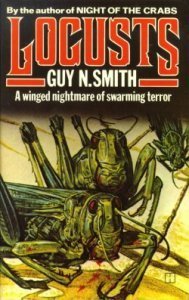“Locusts” is a horror novel by Guy N. Smith, published in 1980. It’s one of Smith’s many works in the horror genre, known for its blend of suspense, action, and ecological themes.

Plot Summary
Nestled amidst the serene Shropshire hills, the Alton family’s idyllic move to a quaint smallholding takes a terrifying turn when a forgotten crate of peaches unleashes an unsuspecting menace upon the unsuspecting countryside. Sent by a distant American relative, the crate unwittingly harbors a handful of Pennsylvanian locusts, whose insidious presence is initially overlooked in the chaos of relocation.
As the relentless heatwave sweeps the nation, more locusts flock northward, drawn by the promise of ample sustenance. With alarming speed, the few locusts burgeon into a teeming horde, their voracious appetites laying waste to crops, foliage, and anything else unfortunate enough to cross their path. As the crisis escalates, Britain awakens to a chilling reality—a state of emergency has been declared, and the nation finds itself ensnared in the clutches of an ecological catastrophe.
In this gripping tale of nature gone awry, author [Author Name] deftly explores the precarious balance between humanity and the natural world, weaving a narrative that resonates with urgency and suspense. As the Alton family grapples with the consequences of their unwitting oversight, they find themselves thrust into the forefront of a battle against an adversary that knows no bounds.
With each passing moment, the locust swarms multiply and spread, leaving a trail of devastation in their wake. As communities mobilize in a desperate bid to contain the onslaught, the true extent of the crisis becomes painfully clear—survival itself hangs in the balance, and humanity must unite against a common foe if it hopes to emerge victorious.
Against a backdrop of escalating tension and heart-stopping suspense, “Swarm” delivers a riveting exploration of the fragility of civilization in the face of nature’s wrath. As the Alton family and their fellow countrymen confront the specter of annihilation, they must summon all their courage and resilience to stand against the relentless tide of destruction.
With its compelling narrative and pulse-pounding action, “Swarm” is a must-read for fans of eco-horror and apocalyptic fiction alike. As the locusts descend upon Britain with relentless fury, readers are drawn into a world where survival is a matter of sheer determination and the will to endure against impossible odds.
Themes and Style
- Nature’s Revenge: “Locusts” explores the theme of nature turning against humanity, with the swarm of locusts representing the ecological consequences of human activity and environmental degradation.
- Action and Suspense: The novel is characterized by its fast-paced action sequences and suspenseful encounters with the swarm of locusts, keeping readers on the edge of their seats throughout.
- Environmental Commentary: Like other works by Smith, “Locusts” incorporates themes of environmental destruction and the consequences of human negligence on the natural world, reflecting the author’s concerns about the state of the environment.
Reception
“Locusts” received generally positive reviews from readers and critics, who praised its atmospheric setting, gripping plot, and memorable characters. The novel’s blend of horror, action, and ecological commentary resonated with audiences, making it a standout entry in Smith’s bibliography.
Author Background
Guy N. Smith (1939-2020) was a British author known primarily for his horror fiction. With over 100 novels to his name, Smith’s works often featured elements of the supernatural, the macabre, and the grotesque. He gained widespread recognition for his ability to create thrilling and suspenseful horror narratives.
Legacy
“Locusts” remains a classic example of Guy N. Smith’s talent for crafting chilling and atmospheric horror stories. While it may not be as well-known as some of his other works, it offers readers a compelling journey into the realm of natural terror, showcasing Smith’s ability to create suspenseful and unsettling storytelling.